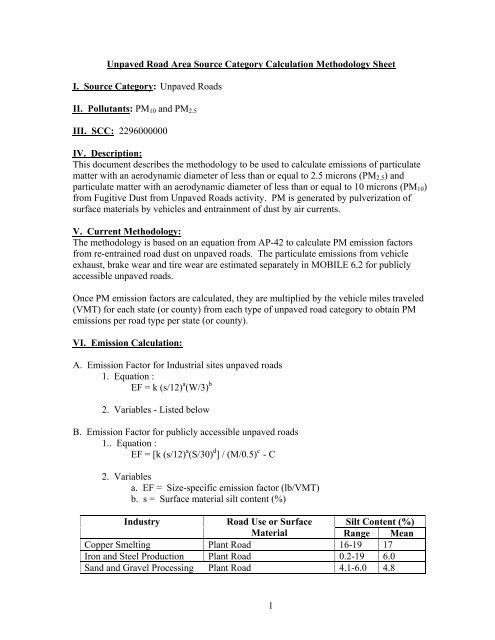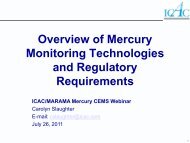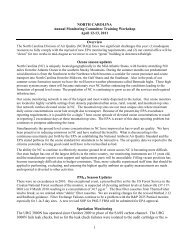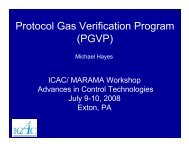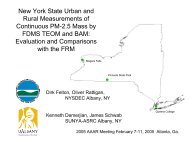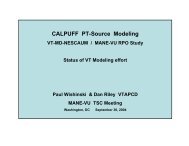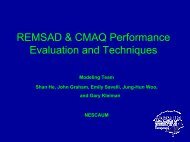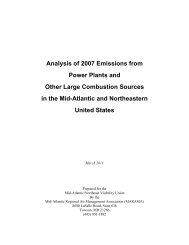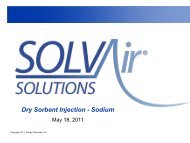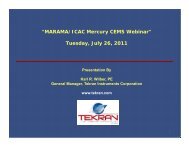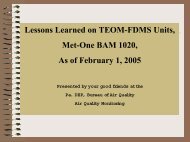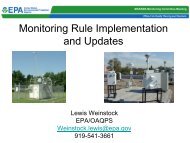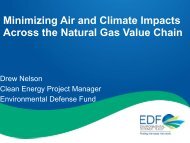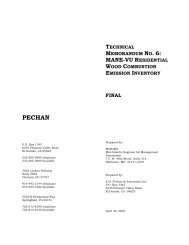Unpaved Roads - MARAMA
Unpaved Roads - MARAMA
Unpaved Roads - MARAMA
Create successful ePaper yourself
Turn your PDF publications into a flip-book with our unique Google optimized e-Paper software.
<strong>Unpaved</strong> Road Area Source Category Calculation Methodology Sheet<br />
I. Source Category: <strong>Unpaved</strong> <strong>Roads</strong><br />
II. Pollutants: PM 10 and PM 2.5<br />
III. SCC: 2296000000<br />
IV. Description:<br />
This document describes the methodology to be used to calculate emissions of particulate<br />
matter with an aerodynamic diameter of less than or equal to 2.5 microns (PM 2.5 ) and<br />
particulate matter with an aerodynamic diameter of less than or equal to 10 microns (PM 10 )<br />
from Fugitive Dust from <strong>Unpaved</strong> <strong>Roads</strong> activity. PM is generated by pulverization of<br />
surface materials by vehicles and entrainment of dust by air currents.<br />
V. Current Methodology:<br />
The methodology is based on an equation from AP-42 to calculate PM emission factors<br />
from re-entrained road dust on unpaved roads. The particulate emissions from vehicle<br />
exhaust, brake wear and tire wear are estimated separately in MOBILE 6.2 for publicly<br />
accessible unpaved roads.<br />
Once PM emission factors are calculated, they are multiplied by the vehicle miles traveled<br />
(VMT) for each state (or county) from each type of unpaved road category to obtain PM<br />
emissions per road type per state (or county).<br />
VI. Emission Calculation:<br />
A. Emission Factor for Industrial sites unpaved roads<br />
1. Equation :<br />
EF = k (s/12) a (W/3) b<br />
2. Variables - Listed below<br />
B. Emission Factor for publicly accessible unpaved roads<br />
1.. Equation :<br />
EF = [k (s/12) a (S/30) d ] / (M/0.5) c - C<br />
2. Variables<br />
a. EF = Size-specific emission factor (lb/VMT)<br />
b. s = Surface material silt content (%)<br />
Industry<br />
Road Use or Surface Silt Content (%)<br />
Material Range Mean<br />
Copper Smelting Plant Road 16-19 17<br />
Iron and Steel Production Plant Road 0.2-19 6.0<br />
Sand and Gravel Processing Plant Road 4.1-6.0 4.8<br />
1
Stone Quarrying and<br />
Processing<br />
Taconite mining and<br />
processing<br />
Western Surface Coal<br />
Mining<br />
Material Storage Area 7.1 7.1<br />
Plant Road 2.4-16 10<br />
Haul Road to/from pit 5.0-15 8.3<br />
Service Road 2.4-7.1 4.3<br />
Haul Road to/from pit 3.9-9.7 5.8<br />
Haul Road to/from pit 2.8-18 8.4<br />
Plant Road 4.9-5.3 5.1<br />
Scraper Route 7.2-25 17<br />
Haul Road (freshly graded) 18-29 24<br />
Construction Sites Scraper Route 0.56-23 8.5<br />
Lumber Sawmills Log Yards 4.8-12 8.4<br />
Municiple Solid Waste Disposal Routes 2.2-21 6.4<br />
Landfills<br />
Publicly Accessible <strong>Roads</strong> Gravel/crushed limestone 0.1-15 6.4<br />
Dirt (i.e local material<br />
compacted, bladed and<br />
crowned)<br />
0.83-68 11<br />
c. W = Mean vehicle weight (tons)<br />
i. Average default value = 2.2 tons<br />
d. M = Surface material moisture content (%)<br />
e. S = Mean vehicle speed (mph)<br />
f. k, a, b, c, and d are empirical constants, listed below:<br />
Constant<br />
k<br />
(lb/VMT)<br />
Industrial <strong>Roads</strong><br />
Public <strong>Roads</strong><br />
PM 2.5 PM 10 PM 2.5 PM 10<br />
0.23 1.5 0.27 1.8<br />
a 0.9 0.9 1 1<br />
b 0.45 0.45 - -<br />
c - - 0.2 0.2<br />
d - - 0.5 0.5<br />
Quality<br />
Rating<br />
C B C B<br />
g. C = emission factor for 1980’s vehicle fleet exhaust, brake wear and tire<br />
wear<br />
Particle Size Range<br />
C, Emission Factor for exhaust,<br />
Brake Wear and Tire Wear<br />
Lb/VMT<br />
PM 2.5 0.00036<br />
2
PM 10 0.00047<br />
3. Calculation for PM 2.5 Emission Factor on Publicly Accessible <strong>Unpaved</strong> <strong>Roads</strong><br />
EF = [k (s/12) a (S/30) d ] / (M/0.5) c - C<br />
EF = [0.27 (8.5/ 12) 1 (25/30) 0.5 ] / (5/0.5) 0.2 - 0.00036<br />
EF = 0.1097967 lb/VMT<br />
C. Adjustment for Precipitation<br />
1. Equation<br />
E ext = EF [(365 - P) / 365]<br />
2. Variables<br />
a. E ext = Annual size-specific emission factor adjusted for precipitation<br />
(lb/VMT)<br />
b. EF = Size-specific emission factor (lb/VMT)<br />
c. P = Number of days in a year with at least 0.254 mm (0.01 in) of<br />
precipitation<br />
3. Calculation of Annual Emission Factor adjusted for Precipitation on unpaved<br />
roads (public access)<br />
E ext = EF x [(365 - P) / 365]<br />
E ext = 0.1097967 x [(365-128)/ 365]<br />
E ext = 0.0712926 lb/ VMT<br />
D. PM Emissions Calculation for State and Road Type<br />
1. Equation:<br />
UPVD_EMIS ST,y = VMT ST,y x E ext<br />
2. Variables:<br />
a. UPVD_EMIS ST,y = State PM emissions from unpaved roads for each<br />
roadtype y<br />
b. VMT ST,y = Total State VMT for unpaved roads for road type y<br />
c. E ext = annual size specific PM emissions factor adjusted for<br />
precipitation<br />
E. PM Emissions Calculation for County and Road type<br />
1. Equation:<br />
UPVD_EMIS x,y = UPVD_EMIS ST,y x VMT x,y / VMT ST,Y<br />
2. Variables<br />
a. UPVD_EMIS x,y = PM emissions from unpaved roads for county x and<br />
roadtype y<br />
b. UPVD_EMIS ST,y = State PM emissions from unpaved roads for each<br />
roadtype y<br />
c. VMT x,y = VMT for unpaved roads in county x and for road type y<br />
d. VMT ST,y = Total State VMT for unpaved roads for road type y<br />
3
VII. Point Source Adjustments:<br />
If fugitive emissions from private unpaved roads located at point sources are accounted for<br />
in the point source calculations, then these emissions should be subtracted from the area<br />
source inventory to avoid double-counting.<br />
VIII. Adjustments for Controls:<br />
Controls for fugitive dust sources involve vehicle restrictions, surface improvement,<br />
surface treatment, or reduction of surface wind speed with windbreaks or source<br />
enclosures. In a Technical Memorandum to EPA, MRI (MRI, 2001) provides an equation<br />
to calculate the control efficiency from watering roads. As this method isn’t validated by<br />
EPA, it isn’t included in this document, but is available for your reference at the AP-42<br />
website.<br />
IX. Spatial Adjustments:<br />
Any state specific VMT data should be applied for unpaved roads if available. The NEI<br />
VMT data for unpaved roads is obtained from national databases and is available only for<br />
state totals and is allocated to counties.<br />
X. Temporal Adjustments:<br />
Temporal adjustments are not available for this category.<br />
XI. Assumptions:<br />
A. Mean vehicle weight (W) of 2.2 tons (based on average vehicle weight for a typical<br />
vehicle mix).<br />
B. Surface material silt content (S) (state averages based on a set of measurement data<br />
collected over the past 15 years).<br />
C. Surface material moisture content under dry, uncontrolled conditions (M dry ).<br />
D. Number of days in the month with greater than 0.01inches of precipitation (P)<br />
(representative weather station)<br />
XII. Rule Effectiveness:<br />
There are no known rules that would affect these calculations.<br />
XIII. Uncertainties/Shortcomings of Methodology<br />
A. <strong>Unpaved</strong> road source conditions have extreme variations and actual emissions can vary<br />
by orders of magnitude pointing out the importance of using as much local data as possible<br />
in the empirical equation.<br />
B. The national method uses a default value for vehicle weight of 2.2 tons may not apply<br />
in all areas and should be reviewed for each specific area.<br />
C. Average values for silt content are used for entire state areas. The values are based on<br />
some 200 samples in 30 states. The average silt content was calculated for each state that<br />
had at least three representative samples. Emissions from states without sample<br />
representation were assumed to have a silt content of the average of all 200 samples.<br />
4
D. Precipitation data for a state was collected from one meteorological station to represent<br />
precipitation for the rural areas of the state.<br />
E. VMT for unpaved roads as obtained from available national databases is not reliable.<br />
Moreover, it is available only for state totals and must be allocated to counties, which<br />
introduces considerable error.<br />
F. The current emission factors may overpredict emissions for mean vehicle speeds below<br />
15 mph.<br />
G. The moisture term does not isolate the effect of watering a specific road.<br />
H. The emissions factor equation was developed only from tests on traffic on unpaved<br />
roads in a range of certain source conditions (see below).<br />
Range of Source Conditions used in developing the Emission Factor Equation<br />
Emission<br />
Factor<br />
Surface<br />
Silt<br />
Mean Vehicle<br />
Weight<br />
Mean Vehicle<br />
Speed<br />
Mean<br />
No. of<br />
Surface<br />
Moisture<br />
Content<br />
%<br />
Mg Ton Km/hr mph Wheels Content<br />
%<br />
Industrial 1.8-25.2 1.8-260 2-290 8-69 5-46 4-17 0.03-13<br />
<strong>Roads</strong><br />
Public<br />
<strong>Roads</strong><br />
1.8-35 1.4-2.7 1.5-3 16-88 10-55 4-4.8 0.03-13<br />
XIV. Recommendations to Improve Methods/Data<br />
A. Update values for VMT on unpaved roads by county with local data<br />
B. Update the local area’s ADTV, and road classification<br />
C. Estimates of actual local silt content on unpaved road surfaces will enhance accuracy of<br />
emissions estimates.<br />
D. The moisture content in the national emission calculation is based on the precipitation<br />
from one reporting station in each state. Use local precipitation data that better represents<br />
the closest reporting station in the area will further improve the accuracy of the estimates.<br />
XV. Additional Information/Guidance:<br />
EPA Contact: Mr. William B. Kuykendal, MD-14<br />
Emission Factor and Inventory Group<br />
E-mail: Kuykendal.Bill@epa.gov<br />
Telephone: 919-541-5372<br />
National Air Pollutant Emissions Trends Procedures Document for 1900-1999<br />
www.epa.gov/ttn/chief/publications.html<br />
AP-42, Section 13.2.2<br />
http://www.epa.gov/ttn/chief/ap42/ch13/final/c13s0202.pdf<br />
NEI Methodology Description:<br />
www.epa.gov/ttn/chief/trends/procedures/ (Section 4.8.1.4, pages 4-248 –<br />
4-253) Note: This document is currently being revised.<br />
5
Procedures for Sampling Surface/Bulk Dust Loading<br />
www.epa.gov/ttn/chief/ap42/appendix/app-c1<br />
Procedure for Laboratory Analysis of Surface/Bulk Loading Samples<br />
http://www.epa.gov/ttn/chief/ap42/appendix/app-c2.pdf<br />
XVI. References:<br />
Emission Inventory Improvement Program, EIIP Document Series - Volume IX,<br />
Particulate Emissions, Fugitive Dust from <strong>Unpaved</strong> <strong>Roads</strong><br />
http://www.epa.gov/ttn/chief/eiip/techreport/volume09/unpavd3.pdf<br />
Midwest Research Institute, Technical Memorandum, subject: Revisions to AP-42 Section<br />
13.2.2, “<strong>Unpaved</strong> <strong>Roads</strong>,” EPA Contract 68-D-1-002, Work Assignment No. 1-03, MRI<br />
Project No. 110130.1.003, September 2001.<br />
http://www.epa.gov/ttn/chief/ap42/ch13/draft/d13s02-2memo_oct2001.pdf<br />
AP42 Section 13.2.2, “<strong>Unpaved</strong> <strong>Roads</strong>,” Environmental Protection Agency, October 2001.<br />
U.S. Environmental Protection Agency. National Air pollutant emission trends procedures<br />
document for 1900-1996, May 1998.<br />
6


